|
The Gods Who Came
to Planet Earth
Nowadays, we take space flight for granted. We can read of plans for
permanently orbiting space settlements without blinking an eye; the
development of a reusable space shuttle is viewed not with
wonderment, but with appreciation of its cost-saving potentialities.
All this, of course, because we have seen with our own eyes, in
print and on television, astronauts fly in space and unmanned craft
land on other planets.
We accept space travel and interplanetary
contacts because we have heard with our own ears a mortal named Neil
Armstrong, commander of the Apollo 11 spacecraft, report on his
radio—for all the world to hear—the first landing by Man on another
celestial body, the Moon:
Houston!
Tranquility Base here.
The Eagle has landed!
Eagle was not only the code-name for the Lunar Module, but the
epithet by which the Apollo 11 spacecraft was called, and the proud
nickname by which the three astronauts identified themselves (Fig.
26). The Falcon too has soared into space, and landed on the Moon.
In the immense National Air and Space Museum of the Smithsonian
Institution in Washington, one can see and touch the actual
spacecraft that were flown or that were used as backup vehicles in
the American space program. In a special section where the Moon
landings have been simulated with the aid of the original equipment,
the visitor can still hear a recorded message from the surface of
the Moon:
O.K., Houston.
The Falcon is on the plain at Hadley!
Whereupon the Manned Spacecraft Center at Houston announced to the
world:
"That was a jubilant Dave Scott reporting Apollo 15 on the
plain at Hadley."
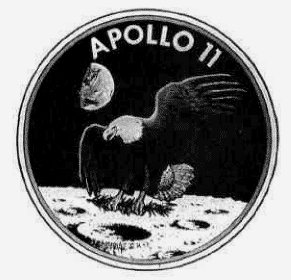
Fig. 26
Up to a few decades ago, the notion that a common mortal can put on
some special clothes, strap himself in the front part of a long
object, then zoom off the face of Earth, seemed preposterous or
worse. A century or two ago, such a notion would not have even come
about, for there was nothing in human experience or knowledge to
trigger such fantasies.
Yet, as we have just described, the Egyptians—5,000 years ago—could
readily visualize all this happening to their Pharaoh: he would
journey to a launch site east of Egypt; he would enter a
subterranean complex of tunnels and chambers; he would safely pass
by the installation's atomic plant and radiation chamber. He would
don the suit and gear of an astronaut, enter the cabin of an
Ascender, and sit strapped between two Gods. And then, as the
double-doors would open, and the dawn skies would be revealed, the
jet engines would ignite and the Ascender would turn into the
Celestial Ladder by which the Pharaoh will reach the Abode of the
Gods on their "Planet of Millions of Years."
On what TV screens had the Egyptians seen such things happen, that
they so firmly believed that all this was really possible?
In the absence of television in their homes, the only alternative
would have been to either go to the Spaceport and watch the
rocketships come and go, or visit a "Smithsonian" and see the craft
on display, accompanied by a knowing guide or viewing flight
simulations. The evidence suggests that the ancient Egyptians had
indeed done that: they had seen the launch site, and the hardware,
and the astronauts with their own eyes. But the astronauts were not
Earthlings going elsewhere: they were, rather, astronauts from
elsewhere who had come to Planet Earth.
Greatly enamored with art, the ancient Egyptians depicted in their
tombs what they had seen and experienced in their lifetimes. The
architecturally detailed drawings of the subterranean corridors and
chambers of the Duat come from the tomb of Seti I. An even more
startling depiction has been found in the tomb of Huy, who was
viceroy in Nubia and
in the Sinai peninsula during the reign of the renowned Pharaoh
Tut-Ankh-Amon.
Decorated with scenes of people, places and objects
from the two domains of which he was viceroy, his tomb preserved to
this very day a depiction in vivid colors of a rocketship: its shaft
is contained in an underground silo, its upper stage with the
command module is above ground (Fig. 27). The shaft is subdivided,
like a multi-stage rocket. Inside its lower part, two persons attend
to hoses and levers; there is a row of circular dials above them.
The silo cutaway shows that it is surrounded by tubular cells for
heat-exchange or some other energy-related function.
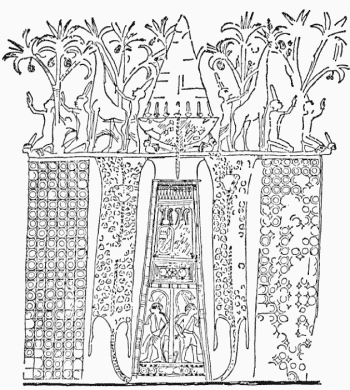
Fig. 27
Above ground, the hemispherical base of the upper stage is clearly
depicted in the color painting as scorched, as though from a
re-entry into Earth's atmosphere. The command module—large enough to
hold three to four persons—is conical in shape, and there are
vertical "peep holes" all around its bottom. The cabin is
surrounded by worshippers, in a landscape of date palm trees and
giraffes.
The underground chamber is decorated with leopard skins, and this
provides a direct link with certain phases in the Pharaoh's Journey
to Immortality. The leopard skin was the distinctive garb
symbolically worn by the Shem priest as he performed the Opening of
the Mouth ceremony. It was the distinctive garb symbolically worn by
the Gods who towed the Pharaoh through "The Secret Path of the
Hidden Place" of the Duat—a symbolism repeated to stress the
affinity between the Pharaoh's journey and the rocketship in the
underground silo.
As the Pyramid Texts make clear, the Pharaoh, in his Translation
into an eternal Afterlife, embarked on a journey simulating the
Gods. Ra and Seth, Osiris and Horus and other Gods had ascended to
the heavens in this manner. But, the Egyptians also believed, it was
by the same Celestial Boat that the Great Gods had come down to
Earth in the first place. At the city of An (Heliopolis), Egypt's
oldest center of worship, the God Ptah built a special structure—a
"Smithsonian Institution," if you will—wherein an actual space
capsule could be viewed and revered by the people of Egypt!
The secret object—the Ben-Ben—was enshrined in the Het Benben, the
"Temple of the Benben." We know from the hieroglyphic depiction of
the place's name that the structure looked like a massive launch
tower from within which a pointed rocket was poised skyward (Fig.
28).

Fig. 28
The Ben-Ben was, according to the ancient Egyptians, a solid object
that had actually come to Earth from the Celestial Disk. It was the
"Celestial Chamber" in which the great God Ra himself had landed on
Earth; the term Ben (literally: "That Which Flowed Out") conveying
the combined mean-ings of "to shine" and "to shoot up in the sky."
An inscription on the stela of the Pharaoh Pi-Ankhi (per Brugsch,
Dictionnaire Geographique de l'Ancienne Egypte) said thus:
The king Pi-Ankhi mounted the stairs toward the large window, in
order to view the God Ra within the Ben-Ben. The king personally,
standing up and being all alone, pushed apart the bolt and opened
the two door-leaves. Then he saw his father Ra in the splendid
sanctuary of Het-Benben. He saw the Maad, Ra's Barge; and he saw
Sektet, the Barge of the Aten.
The shrine, we know from the ancient texts, was guarded and serviced
by two groups of Gods. There were those "who are outside the
Het-Benben" but were allowed into the shrine's most sacred parts,
for it was their task to receive the offerings from the pilgrims and
bring them into the temple. The others were primarily guardians, not
only of the Ben-Ben itself, but of all "the secret things of Ra
which are in Het-Benben."
Much as tourists nowadays flock to the
Smithsonian to view, admire and even touch the actual vehicles flown
in space, so did the devout Egyptians make pilgrimages to
Heliopolis, to revere and pray to the Ben-Ben—probably with a
religious fervor akin to that of the faithful Muslims who make
pilgrimages to Mecca, there to pray at the Qa'aba (a black stone
believed to be a replica of God's "Celestial Chamber").
At the shrine, there was a fountain or well, whose waters acquired a
reputation for their healing powers, especially in matters of
virility and
fertility. The term Ben and its hieroglyphic depiction ∆in time
indeed
acquired the connotations virility and reproduction; and could well
have been the source of the meaning "male offspring'' that Ben has
in Hebrew. In addition to virility and reproduction, the shrine also
acquired the attributes of rejuvenation; this in turn gave rise to
the legend of the Ben bird, which the Greeks who had visited Egypt
called the Phoenix. As these legends had it. the Phoenix was an
eagle with plumage partly red and partly golden; once every 500
years, as it was about to die, it went to Heliopolis and in some
manner rose again from the ashes of itself (or of its father).
Heliopolis and its healing waters remained venerated until early
Christian times; local traditions claim that when Joseph and Mary
escaped to Egypt with the child Jesus, they rested by the shrine's
well.
The shrine at Heliopolis, Egyptian histories tell, was destroyed
several times by enemy invaders. Nothing remains of it nowadays; the
Ben-Ben is also gone. But it was depicted on Egyptian monuments as a
conical chamber within which a God could be seen. Archaeologists
have in fact found a stone scale-model of the Ben-Ben. showing a God
at its open hatch-door in a gesture of welcome (Fig. 29).
The true
shape of the Celestial Chamber was probably accurately depicted in
the tomb of Huy (Fig. 27); that modern command modules—the capsules
housing the astronauts atop rocketships at launching, and in which
they splash down back to Earth— Fig. 30—look so similar to the
Ben-Ben. is no doubt a result of similarity of purpose and function.
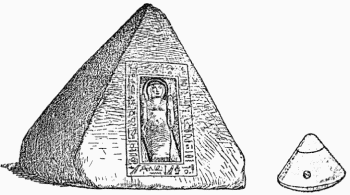
Fig. 29
Fig. 30
In the absence of the Ben-Ben itself, is
there any other physical piece of evidence—and not mere drawings or
scale models—left from the Heliopolitan shrine? We have noted above that according to
Egyptian texts there were other secret things of Ra on display or in
safekeeping at the shrine. In the Book of the Dead nine objects
affiliated with the hieroglyph for Shem were depicted in the
division paralleling the shrine of Heliopolis;
it could well be that there were indeed another nine space-related
objects or spacecraft parts on display at the shrine.
Archaeologists may also have found a replica of one of these smaller
objects. It is an oddly shaped circular object full of intricate
curves and cutouts (Fig. 31a); it has baffled all scholars since its
discovery in 1936. It is important to realize that the object was
found—among other "unusual copper objects"—in the tomb of the crown
prince Sabu, son of King Adjib of the First Dynasty. It is,
therefore, certain that the object was placed in the tomb circa 3100
B.C. It could have been older, but certainly not more recent, than
that date.
Reporting on the discoveries in northern Saqqara (just south of the
great pyramids at Gizah), Walter B. Emery (Great Tombs of the First
Dynasty) described the object as a "bowl-like vessel of schist," and
remarked that "No satisfactory explanation of the curious design of
this object has been forthcoming." The object was carved from a
solid block of schist—a rock which is very brittle and which easily
splits into thin, irregular layers.
If it were put to any use, it
would have quickly broken apart; so the particular stone was chosen
because the very unusual and delicate shape could best be carved out
in such a material—a means to preserve the shape, rather than to
actually use it. This has led other scholars, such as Cyril Aldred
(Egypt to the End of the Old Kingdom) to conclude that the stone
object "possibly imitates a form originally made in metal."
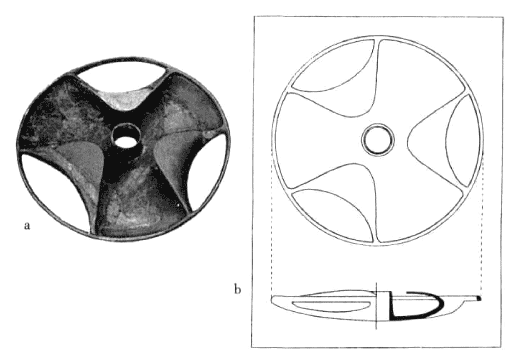
Fig. 31
But what metal could have been used in the fourth millennium B.C. to
produce the object, what process of precision grinding, what skilled
metallurgists were then available to create such a delicate and
structurally complex design? And, above all, for what purpose?
A technical study of the object's unique design (Fig. 31b) shed
little light on its use or origin. The round object, some
twenty-four inches in diameter and less than four inches at its
thickest part, was obviously made to fit over a shaft and rotate
around an axle. Its three oddly curving cutouts suggest a possible
immersion in a liquid during rotation.
There was no further effort made after 1936 to unravel the object's
enigma. But its possible function suddenly sprang to our mind in
1976 on reading in a technical magazine of some revolutionary
designs of a flywheel being developed in California in connection
with the American space program. The flywheel, attached to a
rotating shaft of a machine or an engine, has been in use for less
than two centuries as a means of regulating the speed of machinery,
as well as for accumulating energy for a single spurt, such as in a
metal press (or more recently in aviation).
As a rule, flywheels have had heavy rims, for the energy' is stored
in the wheel's circumference. But in the 1970s, engineers of the
Lockheed Missile & Space Company came up with an opposite design—a
light-rimmed wheel, claiming it is best suited for saving energy in
mass transit trains or storing energy in electrically powered
trolley-buses. The research was continued by the Airesearch
Manufacturing Company; the model they developed—but never finally
perfected—was to be hermetically sealed within a housing filled with
lubricant.
That their revolutionary flywheel (Fig. 32) looks like
the 5,000-year-old object discovered in Egypt is only less amazing
than the fact that the perfected object from 3100 B.C. looks like a
piece of equipment still in the development stage by space engineers
in
A.D. 1978!
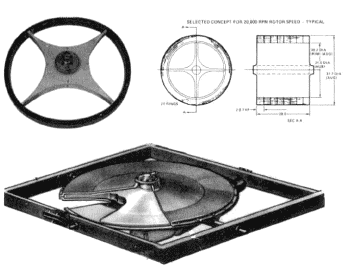
Fig. 32
-
Where is the metal original of this ancient flywheel?
-
Where are the
other objects that were apparently on display at the Heliopolis
shrine?
-
Where, for that matter, is the Ben-Ben itself?
Like so many
artifacts whose existence in antiquity has been documented by the
ancient peoples beyond doubt, they have all disappeared—destroyed
perhaps by natural calamities or wars, perhaps dismantled and taken
elsewhere—as war booty, or for safekeeping and hiding away in places
long forgotten.
Perhaps they were carried back to the heavens;
perhaps they are still with us, unrecognized for what they are in
some museum basement. Or—as the legend of the Phoenix which connects Heliopolis and Arabia might suggest—hidden under the sealed chamber
of the Qa'aba in Mecca ...
We can surmise, however, that the destruction, disappearance or
withdrawal of the shrine's sacred objects had probably taken place
during Egypt's so-called First Intermediary Period. In that period,
the unification of Egypt came apart and total anarchy reigned. We
know that the shrines of Heliopolis were destroyed during the years
of disorder; it was then, perhaps, that Ra left his temple at
Heliopolis and became Amon—the "Hidden God."
When order was first restored in Upper Egypt under the Eleventh
Dynasty, the capital was established at Thebes and the supreme God
was called Amon (or Amen). The Pharaoh Mentuhotep (Neb-Hepet-Ra)
built a
vast temple near Thebes, dedicated it to Ra, and topped it with a
huge "pyramidion" to commemorate Ra's Celestial Chamber (Fig. 33).
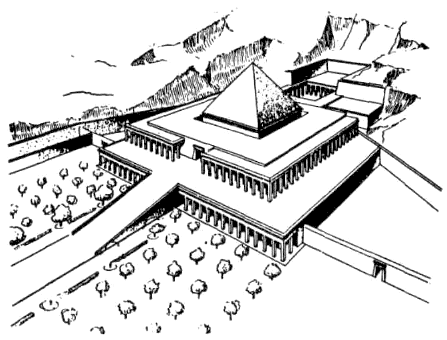
Fig. 33
Soon after 2000 B.C., as the Twelfth Dynasty began its reign, Egypt
was reunited, order was restored, and access to Heliopolis was
regained. The dynasty's first Pharaoh, Amen-Em-Hat I, immediately
undertook the rebuilding of the temples and shrines of Heliopolis;
but whether he could also restore the original artifacts enshrined
there, or had to do with their stone simulations, no one can say for
certain. His son, the Pharaoh Sen-Usert (Kheper-Ka-Ra)—the Sesostris
or Sesonchusis of Greek historians— erected in front of the temple
two huge granite columns (over sixty-six feet high).
On top they
were surmounted with a scale replica of Ra's Celestial Chamber—a pyramidion, which was encased in gold or white copper (electrum).
One of these granite obelisks still stands where it was raised up
some 4,000 years ago; the other was destroyed in the twelfth century
A.D.
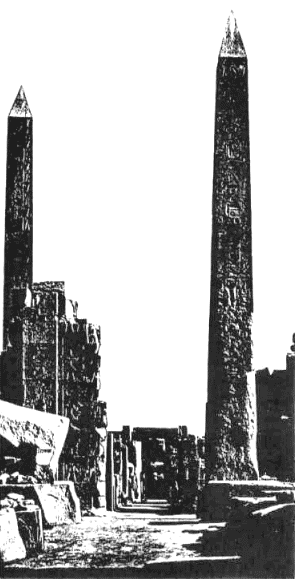
Fig. 34
The Greeks called these pillars obelisks, meaning "pointed cutters."
The Egyptians called them Reams of the Gods. More of them were set
up— always in pairs in front of temple gateways (Fig. 34)—during the
eighteenth and nineteenth dynasties (some were in the end carted off
to New York, London, Paris, Rome).
As stated by the Pharaohs, they
raised these obelisks in order to "obtain (from the Gods) the gift
of Eternal Life," to "obtain Life Everlasting." For the obelisks
simulated in stone what earlier Pharaohs had seen (and purportedly
reached) in the Duat, in the Sacred Mountain: the rocketships of the
Gods (Fig. 35).
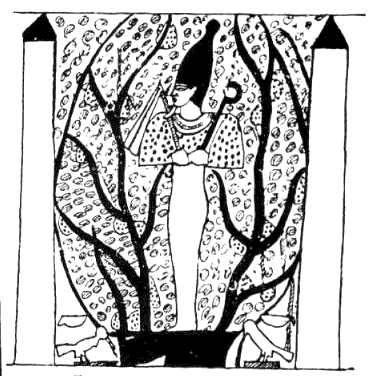
Fig. 35
Today's tombstones, engraved with the deceased's name so that he be
forever remembered, are scaled-down obelisks—a custom rooted in the
days when the Gods and their spacecraft were an absolute reality.
The Egyptian word for these Celestial Beings was
NTR—a term which in
the languages of the ancient Near East meant "One Who Watches." The
hieroglyphic sign for Neter was
 ; like all hieroglyphic signs, it
must have
represented originally an actual, visible object. Suggestions by
scholars have ranged from an axe on a long handle to an ensign. ; like all hieroglyphic signs, it
must have
represented originally an actual, visible object. Suggestions by
scholars have ranged from an axe on a long handle to an ensign.
Margaret A. Murray (The Splendor That Was Egypt) has put forward a
more current view. Showing that pottery from the earliest,
pre-dynastic period was adorned with drawings of boats carrying a
pole with two streamers as a standard (Fig. 36), she concluded that
"the pole with the two streamers became the hieroglyphic sign for
God."
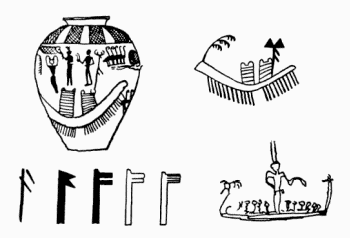
Fig. 36
The interesting point about these earliest drawings is that they
showed the boats arriving from a foreign land. When the drawings
included people, they showed seated rowers commanded by a tall
master, distinguished by the horns protruding from his helmet (Fig.
36)—the mark of being a Neter.
Pictorially, then, the Egyptians affirmed from the very beginning
that their Gods had come to Egypt from elsewhere. This confirmed the
tales of how Egypt began—that the God Ptah. having come from the
south, and having found Egypt inundated, performed great works of
dyking and land reclamation and made the land habitable. There was a
place in Egyptian geography which they called Ta Neter—"Place/Land
of the Gods." It was the narrow straits at the southern end of the
Red Sea which is now called Bab-el-Mandeb; it was through that
strait that the ships bearing the ensign NTR and carrying the horned
Gods had come to Egypt.
The Egyptian name for the Red Sea was the Sea of UR. The term Ta Ur
meant the Foreign Land in the East. Henri Gauthier, who compiled the
Dictionnaire des Noms Geographiques from all the place names in the
hieroglyphic texts, pointed out that the hieroglyph for Ta Ur
"was a
symbol which designated a nautical element ... The sign means that
'You have to go by boat, to the left side.'"
Looking at the map of
the ancient lands (page 19), we see that a turn leftward as one came
from Egypt and passed through the straits of Bab-el-Mandeb, would take the sailor
along the Arabian peninsula toward the Persian Gulf.
There are more clues. Ta Ur literally meant the Land of UR, and the
name Ur was not unknown. It was the birthplace of Abraham, the
Hebrew patriarch. Descended of Shem, the elder son of Noah (the
biblical hero of the Deluge), he was born to his father Terah at the
city of Ur, in Chaldea;
"and Terah took Abram his son, and Lot the
son of Haran, his son's son, and Sarah his daughter-in-law, the wife
of Abram; and they went forth from Ur of the Chaldees, to go into
the Land of Canaan."
When archaeologists and linguists began to unravel, at the beginning
of the nineteenth century, the history and written records of Egypt,
Ur was unknown from any other source except the Old Testament.
Chaldea, however, was known: it was the name by which the Greeks had
called Babylonia, Mesopotamia's ancient kingdom.
The Greek historian Herodotus, who had visited Egypt and Babylonia
in the fifth century B.C., found many similarities in the customs of
the Egyptians and the Chaldeans. Describing the sacred precinct of
the supreme God Bel (whom he called Jupiter Belus) in the city of
Babylon, and its huge stage tower, he wrote that,
"on the upmost
tower there is a spacious temple, and inside the temple stands a
couch of unusual size, richly adorned, with a golden table by its
side. There is no statue of any kind set up in the place, nor is the
chamber occupied by nights by anyone but a native woman, who, as the
Chaldeans, the priests of this God, affirm, is chosen for himself by
the deity... . They also declare ... that the God comes down in
person into this chamber, and sleeps upon the couch. This is like
the story of the Egyptians of what takes place in their city Thebes,
where the woman always passes the night in the temple of the Theban
Jupiter (Amon)."
The more nineteenth-century scholars learnt of Egypt, and matched
the emerging historic picture with the writings of Greek and Roman
historians, the more did two facts stand out: First, that Egyptian
civilization and greatness were not like an isolated flower blooming
in a cultural desert, but part of overall developments throughout
the ancient lands. And secondly, that the biblical tales of other
lands and kingdoms, of fortified cities and trade routes, of wars
and treaties, of migrations and settlements—were not only true, but
also accurate.
The Hittites, known for centuries only from brief mentions in the
Bible, were discovered in Egyptian records as mighty adversaries of
the Pharaohs. A totally unknown page of history—a pivotal battle
between Egyptian armies and Hittite legions which came from Asia
Minor, that had taken place at Kadesh in northern Canaan—was
discovered not only in text, but also depicted pictorially on temple
walls. There was even a historical personal touch, for the Pharaoh
ended up marrying the daughter of the Hittite king in an effort to
cement peace between them.
Philistines, "People of the Sea," Phoenicians, Hurrians, Amorites—
peoples and kingdoms all vouched for, until then, only by the Old
Testament—began to emerge as historical realities as the
archaeological work progressed in Egypt, and began to spill over
into the other lands of the Bible. Greatest of all, however,
appeared to have been the veritable ancient empires of Assyria and
Babylonia; but where were their magnificent temples, and other
remains of their grandeur? And where were their records?
All that travelers had reported from the Land Between The Two
Rivers, the vast plain between the Euphrates and the Tigris, were
mounds—tells in Arabic and Hebrew. In the absence of stone, even the
grandest structures of ancient Mesopotamia were built of mud bricks;
wars, weather and time reduced them to heaps of soil. Instead of
monumental structures, these lands yielded occasional finds of small
artifacts; among them there often were tablets of baked clay
inscribed with wedge-like markings.
Back in 1686, a traveler named Engelbert Kampfer visited Persepolis, the Old Persian capital of the
kings whom Alexander had fought. From monuments there, he copied
signs and symbols in such a wedge-shaped or cuneiform script, as on
the royal seal of Darius (Fig. 37). But he thought that they were
only decorations. When it was finally realized that these were
inscriptions, no one knew what their language was and how they could
be deciphered.
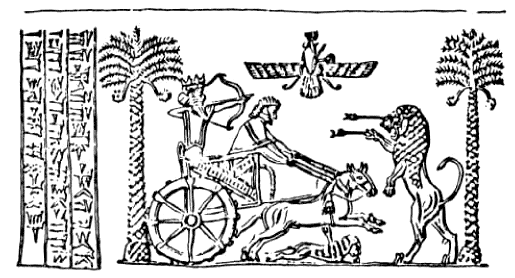
Fig. 37
As in the case of the Egyptian hieroglyphs, so it was with the
cuneiform writings: The key to the solution was a tri-lingual
inscription. It was found carved on the rocks of forbidding
mountains, at a place in Persia called Behistun. In 1835, a major in
the British Army, Henry Rawlinson, managed to copy the inscription,
and thereafter decipher the script and its languages. As it turned
out, the tri-lingual rock inscription was in Old Persian, Elamite
and Akkadian. Akkadian was the mother-language of all the Semitic
languages; and it was through the knowledge of Hebrew that scholars
were
able to read and understand the Mesopotamian inscriptions of the
Assyrians
and the Babylonians.
Spurred by such discoveries, a Paris-born Englishman named Henry
Austen Layard reached Mosul, a caravan junction in northeastern Iraq
(then part of the Ottoman-Turkish Empire) in 1840. There he was the
guest of William F. Ainsworth, whose Researches in Assyria,
Babylonia and Chaldea (1838)—along with earlier reports and small
finds by Claudius J. Rich (Memoir on the Ruins of Babylon)—not only
fired Layard's imagination, but also led to scientific and monetary
support from the British Museum and the Royal Geographical Society.
Versed both in the pertinent biblical references and the Greek
classical writings, Layard kept recalling that an officer in
Alexander's army reported seeing in the area "a place of pyramids
and remains of an ancient city"—a city whose ruins were considered
ancient even in Alexander's times!
His local friends showed him the various tells in the area,
indicating that there were ancient cities buried beneath them. His
excitement grew most when he reached a place called Birs Nimrud.
"I
saw for the first time the great conical mound of Nimrud rising
against the clear evening sky," he later wrote in his Autobiography.
"The impression that it made upon me was one never to be forgotten."
Was it not the place of the buried pyramid seen by Alexander's
officer? And surely was the place associated with the biblical
Nimrod, "the mighty hunter by the grace of the Lord," who launched
the kingdoms and royal cities of Mesopotamia (Genesis X)—
And the beginning of his kingdom: Babel and Erech and Akkad, all in
the
Land of Shin'ar, Out of that land there emanated Ashur, where
Nineveh
was built—a city of wide streets; and Khalah, and Ressen.
With the support of Major Rawlinson, who by then was the British
Resident and Consul in Baghdad, Layard returned in 1845 to Mosul to
begin digging at his cherished Nimrud. But whatever he was to
find—and find he did—the claim to be the first modern archaeologist
in Mesopotamia was not to be his.
Two years earlier, Paul-Emile Botta, the French Consul at Mosul (whom Layard had met and
befriended) proceeded to excavate a mound somewhat north of Mosul,
on the other side of the Tigris River. The natives called the place
Khorsabad; the cuneiform inscriptions uncovered there identified it
as Dur-Sharru-Kin, the ancient capital of the biblical Sargon, king
of Assyria. Commanding the vast city and its palaces and temples was
indeed a pyramid constructed in seven steps, the term for which is
ziggurat (Fig. 38).
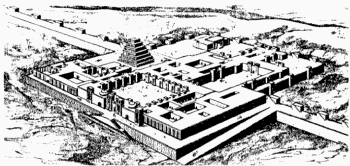
Fig. 38
Spurred by Botta's discoveries, Layard began to dig at his chosen
mound, where he believed he would uncover Nineveh, the Assyrian
capital of biblical renown. Though the place turned out to be the
Assyrian military
center named Kalhu (the biblical Khala), the treasures that were
uncovered were worth the effort. They included an obelisk set up by
King Shal-maneser II, on which he listed among those paying him
tribute "Jehu, son of Omri, king of Israel" (Fig. 39).
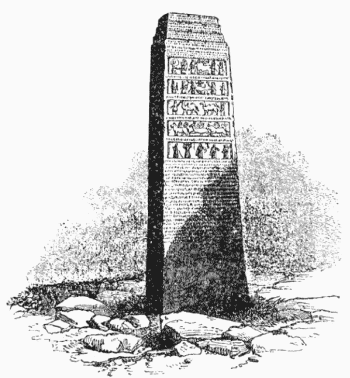
Fig. 39
Assyrian finds now directly confirmed the historical veracity of the
Old Testament.
Encouraged, Layard began to excavate in 1849 a mound directly
opposite Mosul, on the eastern banks of the Tigris. The place,
locally named Kuyunjik, was indeed Nineveh— the capital established
by Sennacherib, the Assyrian king whose army was smitten by the
Lord's angel when he besieged Jerusalem (II Kings 18). After him,
Nineveh served as the capital of Esarhaddon and Ashurbanipal. The
art treasures carted off from there to the British Museum still make
up the most impressive portion of its Assyrian displays.
As the pace of excavations gathered momentum, as archaeological
teams from other nations joined the race, all the Assyrian and
Babylonian cities named in the Bible (with one minor exception) were
uncovered. But as the world's museums filled up with the ancient
treasures, the most important finds were the simple clay
tablets—some small enough to be held in the palm of the scribe's
hand—on which the Assyrians, Babylonians and other peoples of
western Asia wrote down commercial contracts, court rulings,
marriage and inheritance records, geographical lists, mathematical
information, medical formulas, laws and regulations, royal
histories—indeed, every aspect of life by advanced and highly
civilized societies.
Epic tales, Creation tales, proverbs,
philosophical writings, love songs and the like made up a vast
literary heritage. And there were matters celestial—lists of stars
and constellations, planetary information, astronomical tables; and
lists of Gods, their family relationships, their attributes, their
tasks and functions—Gods headed by twelve Great Gods, "Gods of
Heaven and Earth," with whom there were associated the twelve
months, the twelve constellations of the Zodiac, and twelve members
of our solar system.
As the inscriptions themselves occasionally stated, their language
stemmed from the Akkadian. This and other evidence confirmed the
biblical narrative, that Assyria and Babylon (which appeared on the
historical stage circa 1900 B.C.) were preceded by a kingdom named
Akkad. It was founded by Sharru-Kin—"the Righteous Ruler"—whom we
call Sargon I, circa 2400
B.C. Some of his inscriptions were also found; in them he boasted
that by the grace of his God Enlil, his empire stretched from the
Persian Gulf to the Mediterranean Sea. He called himself "King of
Akkad, King of Kish"; and he claimed to have "defeated Uruk, tore
down its wall ... (was) victorious in battle with the inhabitants
of Ur."
Many scholars believe that Sargon I was the biblical Nimrod, so that
the biblical verses apply to him and to a capital named Kish (or
Kush by biblical spelling) where kingship existed even before Akkad:
And Kush begot Nimrod;He was first to be a Mighty Man in the land ...And the beginning of his kingdom:Babel and Erech and Akkad,All in
the Land of Shin'ar.
The royal city of Akkad was discovered southeast of Babylon; the
ancient city of Kish was also discovered, southeast of Akkad.
Indeed, the more archaeologists moved down in the plain between the
two rivers, in a southeasterly direction, the greater was the
antiquity of the places unearthed. At a place now called Warka, the
city of Uruk, which Sargon I claimed to have defeated, the biblical
Erech, was found. It took the archaeologists from the third
millennium B.C. to the fourth millennium B.C.!
There, they found the
first-ever pottery baked in a kiln; evidence of the first-ever use
of a potters wheel; a pavement of limestone blocks which is the
oldest of its kind; the first-ever ziggurat (step pyramid); and the
world's first written records: inscribed texts (Fig. 40) and
engraved cylinder seals (Fig. 41) which, when rolled on wet clay,
left a permanent imprint.
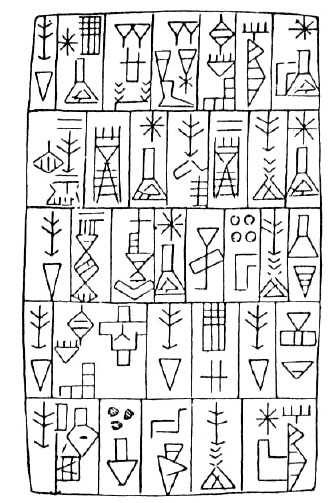
Fig. 40
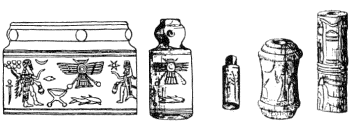
Fig. 41
Ur—birthplace of Abraham—was also found, farther south, where the
coastline of the Persian Gulf had reached in antiquity. It was a
great commercial center, site of a huge ziggurat, the seat of many
dynasties. Was then the southern, more ancient part of Mesopotamia,
the biblical Land of Shin'ar—the place where the events of the Tower
of Babel had taken place?
One of the greatest discoveries in Mesopotamia was the library of
Ashurbanipal in Nineveh, which contained more than 25,000 tablets
arranged by subject. A king of great culture, Ashurbanipal collected
every text he could lay his hands on, and in addition set his
scribes to copy and translate texts otherwise unavailable. Many
tablets were identified by the scribes as "copies of olden texts." A
group of twenty-three tablets, for example, ended with the
postscript: "twenty-third tablet; language of Shumer not changed."
Ashurbanipal himself stated in an inscription:
The God of scribes has bestowed on me the gift of the knowledge of
his art. I have been initiated into the secrets of writing. I can
even read the intricate tablets in Shumerian. I understand the
enigmatic words in the stone carvings from the days before the
Deluge.
In 1853, Henry Rawlinson suggested to the Royal Asiatic Society that
there possibly was an unknown language that preceded Akkadian,
pointing out that the Assyrian and Babylonian texts often used words
borrowed from that unknown language, especially in scientific or
religious texts. In 1869 Jules Oppert proposed at a meeting of the
French Society of Numismatics and Archaeology that recognition be
given to the existence of such an early language and of the people
who spoke and wrote it. He showed that the Akkadians called their predecessors Shumerians, and spoke of the
Land of Shunter (Fig. 42).
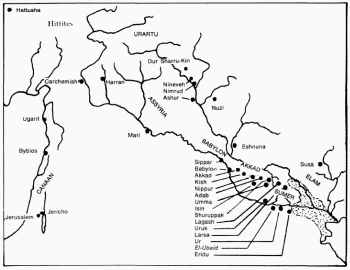
Fig. 42
It was, in fact, the biblical Land of Shin'ar. It was the land whose
name— Shunter—literally meant
Land of the Watchers. It was indeed
the Egyptian Ta Meter—Land of the Watchers, the land from which the
Gods had come to Egypt.
As difficult as it was at the time, scholars have accepted, after
the grandeur and antiquity of Egypt had been unearthed, that
civilization (as known to the West) did not begin in Rome and
Greece. Could it now be, as the Egyptians themselves had suggested,
that civilization and religion began not in Egypt, but in southern
Mesopotamia?
In the century that followed the first Mesopotamian discoveries, it
has become evident beyond doubt that it was indeed in Sumer
(scholars find this spelling easier to pronounce) that modern
Civilization (with a capital 'C') began. It was there, soon after
4000 B.C.—nearly 6,000 years ago—that all the essential elements of
a high civilization suddenly blossomed out, as though from nowhere
and for no apparent reason.
There is hardly any aspect of our
present culture and civilization whose roots and precursors cannot
be found in Sumer: cities, high-rise buildings, streets,
marketplaces, granaries, wharves, schools, temples; metallurgy,
medicine, surgery, textile making, gourmet foods, agriculture,
irrigation; the use of bricks, the invention of the kiln; the
first-ever wheel, carts; ships and navigation; international trade;
weights and measures; kingship, laws, courts, juries; writing and
recordkeeping; music, musical notes, musical instruments, dance and
acrobatics; domestic animals and zoos; warfare, artisanship,
prostitution.
And above all: the knowledge and study of the heavens,
and the Gods "who from the Heavens to Earth had come."
Let it be clarified here that neither the Akkadians nor the
Sumerians had called these visitors to Earth Gods. It is through
later paganism that the notion of divine beings or Gods has filtered
into our language and thinking. When we employ the term here, it is
only because of its general acceptance and usage that we do so.
The Akkadians called them Ilu—"Lofty Ones"—from which the Hebrew,
biblical El stems. The Canaanites and Phoenicians called them Ba'al—
Lord. But at the very beginning of all these religions, the
Sumerians called them DIN.GIR, "the Righteous Ones of the
Rocketships." In the early pictographic writing of the Sumerians
(which was later stylized into cuneiform wedge-writing), the terms
DIN and GIR were written  . .
When the two are combined we can see that the
cutter or GIR—shaped like a conical-pyramidical command module—fits
perfectly into the nose of the DIN, pictured as a multi-stage
rocket. Moreover, if we stand the completed word-picture up, we find
that it is
amazingly similar to the rocket ship in the underground silo
depicted in the Egyptian tomb of Huy (Fig. 43).
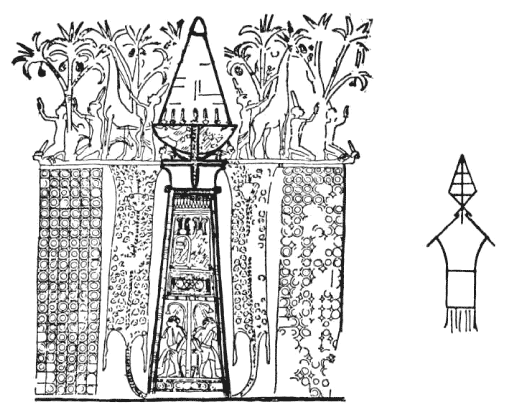
Fig. 43
From the Sumerian cosmological tales and epic poems, from texts that
served as autobiographies of these Gods, from lists of their
functions and relationships and cities, from chronologies and
histories called King Lists, and a wealth of other texts,
inscriptions and drawings, we have pieced together a cohesive drama
of what had happened in prehistoric times, and how it all began.
Their story begins in primeval times, when our solar system was
still young. It was then that a large planet appeared from outer
space and was drawn into the Solar System. The Sumerians called the
invader
NIBIRU — "Planet of the Crossing"; the Babylonian name for
it was Marduk. As it passed by the outer planets, Marduk's course
curved in, to a collision course with an old member of the Solar
System —a planet named Tiamat.
As the two came together, the
satellites of Marduk split Tiamat in half. Its lower part was
smashed into bits and pieces, creating the comets and the asteroid
belt—the "celestial bracelet" of planetary debris that orbits
between Jupiter and Mars. Tiamat's upper part, together with its
chief satellite, were thrown into a new orbit, to become Earth and
the Moon.
Marduk itself, intact, was caught in a vast elliptical orbit around
the Sun, returning to the site of the "celestial battle" between
Jupiter and Mars once in 3,600 Earth-years (Fig. 44). It was thus
that the Solar System ended up with twelve members —the Sun, the
Moon (which the Sumerians considered a celestial body in its own
right), the nine planets we know of, and one more—the twelfth:
Marduk.
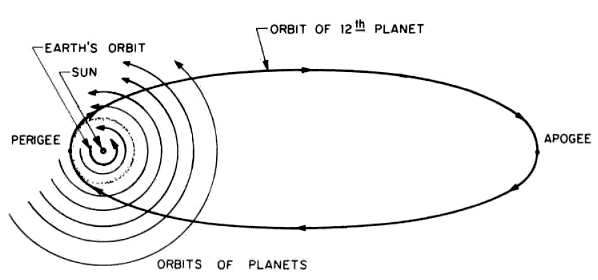
Fig. 44
When Marduk invaded our solar system, it brought with it the seed of
life. In the collision with Tiamat, some of the seed of life was
transferred to its surviving part—Planet Earth. As life evolved on
Earth, it emulated evolution on Marduk. And so it was that when on
Earth the human species just began to stir, on Marduk intelligent
beings had already achieved high levels of civilization and
technology.
It was from that twelfth member of the Solar System, the Sumerians
said, that astronauts had come to Earth —the "Gods of Heaven and
Earth." It was from such Sumerian beliefs, that all the other
ancient peoples acquired their religions and Gods. These Gods, the
Sumerians said, created Mankind and eventually gave it
civilization—all knowledge, all sciences, including an incredible
level of a sophisticated astronomy.
This knowledge encompassed recognition of the Sun as the central
body of the Solar System, cognizance of all the planets we know of
today—even the outer planets Uranus, Neptune and Pluto, which are
relatively recent discoveries of modern astronomy—planets which
could not have been observed and identified with the naked eye. And,
in planetary texts and lists, as well as in pictorial depictions,
the Sumerians insisted that there was one more planet—NIBIRU,
Marduk— which, when nearest Earth, passed between Mars and Jupiter,
as shown on this 4,500-year-old cylinder seal (Fig. 45).
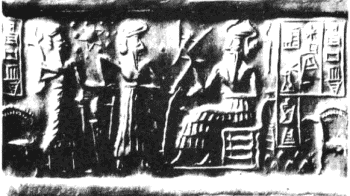
Fig. 45
The sophistication in celestial knowledge—attributed by the
Sumerians to the astronauts who had come from Marduk—was not limited
to familiarity with the Solar System. There was the endless
universe, full of stars. It was first-ever in Sumer—not centuries
later in Greece, as has been thought—that the stars were identified,
grouped together into constellations, given names, and located in
the heavens. All the constellations we now recognize in the northern
skies, and most of the constellations of the southern skies, are
listed in Sumerian astronomical tablets—in their correct order and
by names which we have been using to this very day!
Of the greatest importance were the constellations which appear to
ring the plane or band in which the planets orbit the Sun. Called by
the Sumerians UL.HE ("The Shiny Herd")—which the Greeks adopted as
the zodiakos kyklos ("Animal Circle") and we still call the
Zodiac—they were arranged in twelve groups, to form the twelve
Houses of the Zodiac. Not only the names by which these star groups
were called by the Sumerians— Bull (Taurus), Twins (Gemini), The
Pincer (Cancer), Lion (Leo) and so exactly on—but even their
pictorial depictions have remained unchanged through the millennia
(Fig. 46).
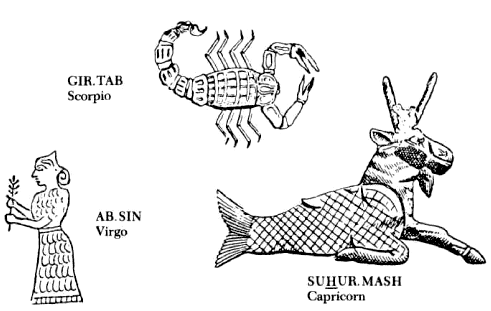
Fig. 46
The much later Egyptian Zodiac
representations were
almost identical to the Sumerian ones (Fig. 47).
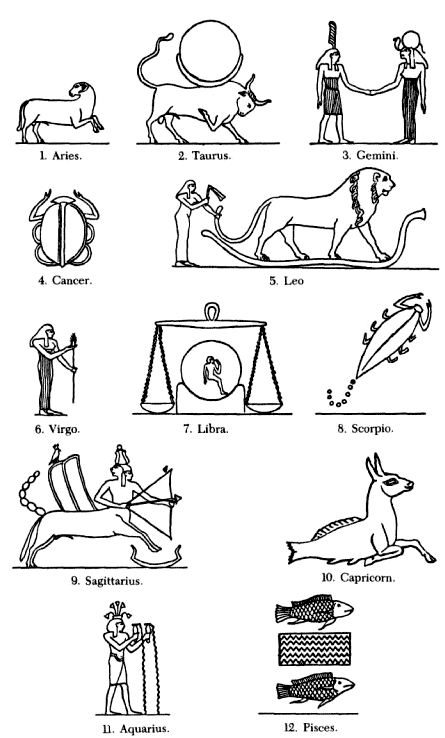
Fig. 47
In addition to the concepts of a spherical astronomy that we employ
to this very day (including the notions of a celestial axis, poles,
ecliptic, equinoxes and the like) which were already perfected in
Sumerian times, there was also the astounding familiarity with the
phenomenon of Precession. As we now know, there is an illusion of a
retardation in Earth's orbit as an observer from Earth pinpoints the
Sun on a fixed date (such as the first
clay of spring) against the Zodiac constellations that act as a
backdrop in space.
Caused by the fact that the Earth's axis is
inclined relatively to its plane of orbit around the Sun, this
retardation or Precession is infinitesimal in terms of human lifespans: in seventy-two years, the shift in the Zodiac backdrop is
a mere 1° of the 360° Celestial Circle.
Since the Zodiac circle surrounding the band in which Earth (and
other planets) orbits around the Sun was divided into an arbitrary
twelve Houses, each takes up one-twelfth of the full circle, or a
celestial space of 30°. It thus takes Earth 2,160 years (72 x 30) to
retard through the full span of a Zodiac House. In other words, if
an astronomer on Earth has been observing (as is now done) the
spring day when the Sun began to rise against the constellation or
House of Pisces, his descendants 2,160 years later would observe the
event with the Sun against the backdrop of the adjacent
constellation, the "House" of Aquarius.
No single man, perhaps even no single nation, could have possibly
observed, noted and understood the phenomenon in antiquity. Yet the
evidence is irrefutable: The Sumerians, who began their
time-counting or calendar in the Age of Taurus (which began circa
4400 B.C.), were aware of and recorded in their astronomical lists
the previous precessional shifts to Gemini (circa 6500 B.C.), Cancer
(circa 8700 B.C.) and Leo (circa 10,900 B.C.)!
Needless to say, it
was duly recognized circa 2200 B.C. that the first day of spring—New
Year to the peoples of Mesopotamia—retarded a full 30° and shifted
to the constellation or "Age" of Aries, the Ram (KU.MAL in
Sumerian).
It has been recognized by some of the earlier scholars who combined
their knowledge of Egyptology/Assyriology with astronomy, that the
textual and pictorial depictions employed the Zodiac Age as a grand
celestial calendar, whereby events on Earth were related to the
grander scale of the heavens.
The knowledge has been employed in
more recent times as a means of prehistoric and historic
chronological aid in such studies as that by
G. de Santillana and H. von Dechend (Hamlet's Mill). There is no
doubt, for example, that the Lion-like Sphinx south of Heliopolis,
or the Ram-like Sphinxes guarding the temples of Karnak, depicted
the Zodiac ages in which the events they stood for had occurred, or
in which the Gods or kings represented had been supreme.
Central to this knowledge of astronomy, and in consequence to all
the religions, beliefs, events and depictions of the ancient world,
was thus the conviction that there is one more planet in our solar
system, a planet with the vastest orbit, a supreme planet or
"Celestial Lord"—the one the Egyptians called the Imperishable Star,
or the "Planet of Millions of Years"—the celestial abode of the
Gods. The ancient peoples, without exception, paid homage to this
planet, the one with the vastest, most majestic orbit. In Egypt, in
Mesopotamia and elsewhere, its ubiquitous emblem was that of the
Winged Globe (Fig. 48).
Recognizing that the Celestial Disk, in Egyptian depictions, stood
for the Celestial Abode of Ra, scholars have persisted in referring
to Ra as a "Sun God" and to the Winged Disk as a "Sun Disk." It
should now be clear that it was not the Sun, but the Twelfth Planet
which was so depicted. Indeed, Egyptian depictions clearly
distinguished between the Celestial Disk representing this planet,
and the Sun.
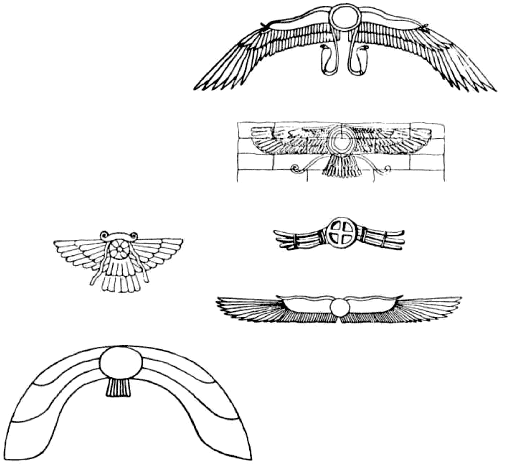
Fig. 48
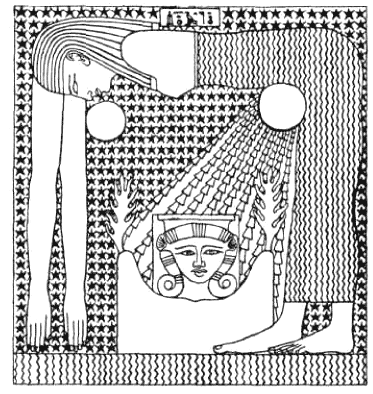
Fig. 49
As can be seen (Fig. 49), both were shown in the
heavens (represented by the arched form of the Goddess Nut);
clearly, then, two celestial bodies and not a single one are
involved. Clearly too, the Twelfth Planet is shown as a celestial
globe or disk—a planet; whereas the Sun is shown emitting its
benevolent rays (in this instance, on the Goddess Hat-Hor, "Lady of
the Mines" of the Sinai peninsula).
Did the Egyptians then, as the Sumerians, know thousands of years
ago that the Sun was the center of the solar system, and that the
system consisted of twelve members? We know that it was so from
actual celestial maps depicted on mummy coffins.
A well-preserved one, discovered by H. K. Brugsch in 1857 in a tomb
at Thebes (Fig. 50), shows the Goddess Nut ("The Heavens") in the
central panel (painted atop the coffin), surrounded by the twelve
constellations of the Zodiac. On the sides of the coffin, the bottom
rows depict the twelve hours of the night and of the day. Then the
planets—the Celestial Gods— are shown traveling in their prescribed
orbits, the Celestial Barques (the Sumerians called these orbits the
"destinies" of the planets).
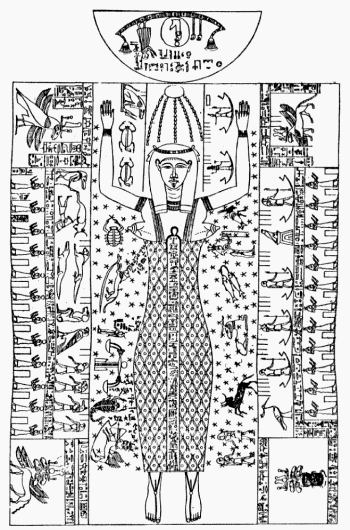
Fig. 50
In the central position, we see the globe of the Sun, emitting rays.
Near the Sun, by Nut's raised left hand, we see two planets: Mercury
and Venus. (Venus is correctly depicted as a female—the only planet
considered female
by all ancient peoples.) Then, in the left-hand panel, we see Earth
(accompanied by the emblem of Horus), the Moon, Mars and Jupiter as
Celestial Gods traveling in their Celestial Barques.
We see four more Celestial Gods beyond Jupiter, on the right-hand
panel. With orbits unknown to the Egyptians (and thus without
Barques), we see Saturn, Uranus, Neptune and Pluto. The time of
mummification is marked by the Spearman pointing his spear into the
midst of the Bull (Taurus).
We thus encounter all the planets in their correct order, including
the outer planets whom modern astronomers discovered only rather
recently (Brugsch, as others of his time, was unaware of the
existence of Pluto).
Scholars who have studied the planetary knowledge in antiquity
assumed that the ancient peoples believed that five planets—the Sun
being one of them—circled Earth. Any depiction or listing of more
planets, these scholars held, was due to some "confusion." But there
was no confusion; rather—impressive accuracy: that the Sun was in
the system's center, that Earth was a planet, and that in addition
to Earth and Moon and the other eight planets known to us today,
there is one more large planet. It is depicted atop all others,
above the head of Nut, as a major Celestial Lord with its own huge
celestial orbit ("Celestial Barque").
Four hundred fifty thousand years ago—according to our Sumerian
sources—astronauts from this Celestial Lord landed on Planet Earth.
Back to Contents
|









 ; like all hieroglyphic signs, it
must have
represented originally an actual, visible object. Suggestions by
scholars have ranged from an axe on a long handle to an ensign.
; like all hieroglyphic signs, it
must have
represented originally an actual, visible object. Suggestions by
scholars have ranged from an axe on a long handle to an ensign.







 .
. 






